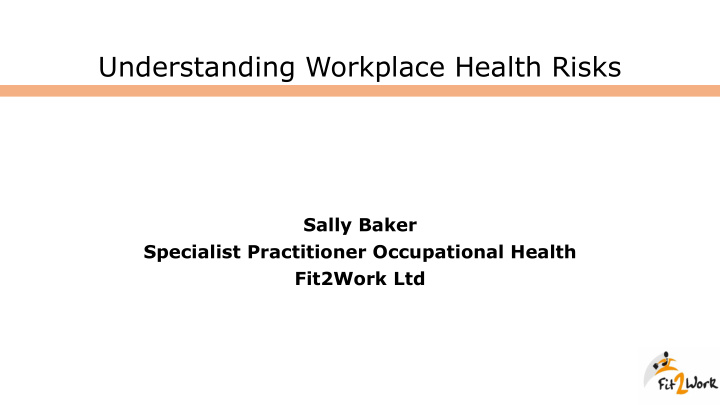



Understanding Workplace Health Risks Sally Baker Specialist Practitioner Occupational Health Fit2Work Ltd
Understanding Workplace Health Risks A Framework for Identifying and Managing potential Occupational Health Risks in the Workplace
Help
Understanding Workplace Health Risks A Framework for Identifying and Managing potential Occupational Health Risks in the Workplace
Understanding Workplace Health Risks Identifying Managing Health Risks
Identifying 1 Risk Assessment • Job Role/hazards • Walk about’s and work place assessments • Employee Reporting Schemes • Analysis of RIDDOR report • Legislation/Regulation/Guidance • Company/Local Policy • Safe Working Practice • Liaison with H&S • Analysis of OH data • Needs assessment •
Understanding Workplace Health Risks Identifying Managing Health Risks
Health Risks • Chemical • Physical • Ergonomic • Biological • Psychological/Organisational
Chemical • Solvents/Coolants • Gases/vapours • Cleaning products • Chemicals used in processes Dry Cleaning • Components for the military • Film making • • Wet cement • Silica • paint
Physical • Noise • Vibration • Heat/Cold • Ergonomics • Radiation
Ergonomic • Workplace design • Lifting and moving • Repetitive movements
Biological Leptospirosis • Legionnaires • Blood Bourne Virus • Infectious diseases •
Psychological/Organisational • Stress - Workplace/Personal • Bullying and Harassment • Shift work
Understanding Workplace Health Risks Identifying Managing Health Risks
Managing Health Surveillance Systematically watching out for early signs of work related ill health in employees exposed to certain health risks. When Why How
Managing Health Surveillance When The work is known to damage health in some way • Valid techniques are available to detect the onset of • ill health It is reasonably likely that the health may be • damaged by particular working practices It is likely to be a benefit to the employee •
Managing Health Surveillance Why To Prevent ill health • To detect early signs of risk to health • To assist in evaluating the effectiveness • of existing risk management measures and identifying where further action may be required To ensure compliance with health and • safety legislation
Managing Health Surveillance How Pre-Placement • Periodic • Exit •
Managing Record • Inform • Review •
NIHL in an employee
Managing Lung FLT Confined Surname Name Job Dept DOB Age Audiometry Cat Function LFT Result Skin HAVS Capability Space Vision TIM Engineer plant 14/02/1962 54 May-17 1 - - - BRADLEY Appren Eng Shop floor 27/05/1993 23 Jul-18 1 Sep 17 NAD Sep-17No Exp
Health Surveillance
Medical Conditions • Diabetes • Hypertension/Cardiac conditions • High cholesterol • Asthma and occupational asthma • COPD • Dermatitis • Acoustic Neuroma • Cancer, Bladder, prostate, skin, testicular, pancreatic, lung, Brain Tumour, eye, breast………… • Visual conditions • Neurological conditions
Types of Health Surveillance • Audio • Spirometry • Vibration - Hand/Body • Skin Assessments • Asbestos • Ionising Radiation • Lead
References Healthy working lives - www. healthyworkinglives .com Working for a healthier Scotland - www.healthscotland.com The occupational health physician - www.bma.org Occupational Health Standards in the construction Industry – Health Improvement Group, HSL Health and Safety Executive www.hse.gov.uk/health-surveillance Health Solutions Centre HSL
Any Questions? Sally Baker SCPHN OH sally@fit2work.co.uk www.fit2work 07796015265
Recommend
More recommend